HRM: Recruitment, Selection, Motivation & Talent Development
VerifiedAdded on 2023/06/11
|10
|3718
|295
Report
AI Summary
This report provides a comprehensive analysis of recruitment, selection, and motivation within Human Resource Management (HRM), using Tesco as a case study. It identifies causes and consequences of poor recruitment and selection processes, highlighting the impact on employee turnover, productivity, and financial performance. The report also explores motivation process theories, including Vroom's expectancy theory, and their roles in the workplace, emphasizing the importance of employee satisfaction and engagement for organizational success. The document concludes by underscoring the need for effective HRM strategies to attract, retain, and motivate employees, ultimately contributing to the overall growth and profitability of the company. Desklib offers similar solved assignments and resources for students.
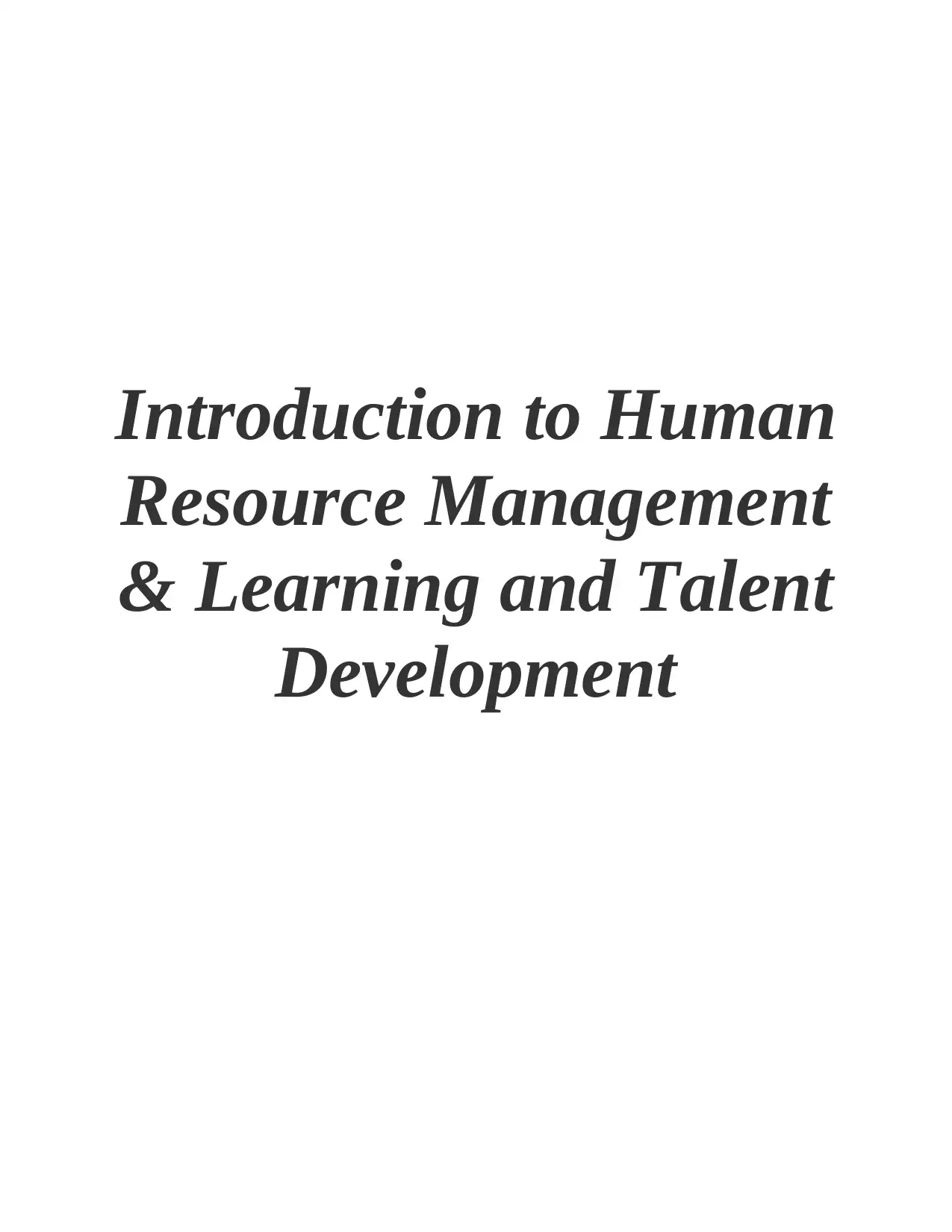
Introduction to Human
Resource Management
& Learning and Talent
Development
Resource Management
& Learning and Talent
Development
Paraphrase This Document
Need a fresh take? Get an instant paraphrase of this document with our AI Paraphraser
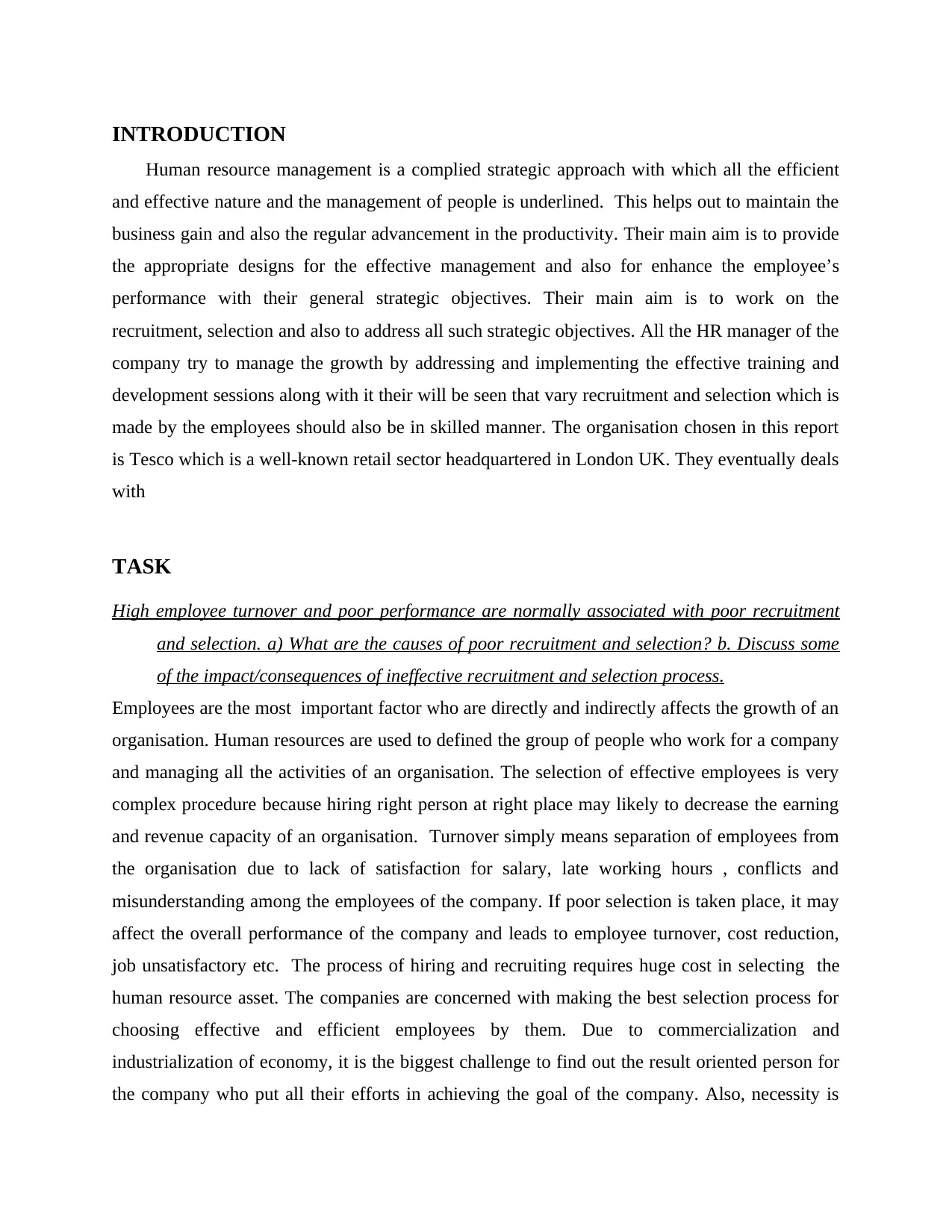
INTRODUCTION
Human resource management is a complied strategic approach with which all the efficient
and effective nature and the management of people is underlined. This helps out to maintain the
business gain and also the regular advancement in the productivity. Their main aim is to provide
the appropriate designs for the effective management and also for enhance the employee’s
performance with their general strategic objectives. Their main aim is to work on the
recruitment, selection and also to address all such strategic objectives. All the HR manager of the
company try to manage the growth by addressing and implementing the effective training and
development sessions along with it their will be seen that vary recruitment and selection which is
made by the employees should also be in skilled manner. The organisation chosen in this report
is Tesco which is a well-known retail sector headquartered in London UK. They eventually deals
with
TASK
High employee turnover and poor performance are normally associated with poor recruitment
and selection. a) What are the causes of poor recruitment and selection? b. Discuss some
of the impact/consequences of ineffective recruitment and selection process.
Employees are the most important factor who are directly and indirectly affects the growth of an
organisation. Human resources are used to defined the group of people who work for a company
and managing all the activities of an organisation. The selection of effective employees is very
complex procedure because hiring right person at right place may likely to decrease the earning
and revenue capacity of an organisation. Turnover simply means separation of employees from
the organisation due to lack of satisfaction for salary, late working hours , conflicts and
misunderstanding among the employees of the company. If poor selection is taken place, it may
affect the overall performance of the company and leads to employee turnover, cost reduction,
job unsatisfactory etc. The process of hiring and recruiting requires huge cost in selecting the
human resource asset. The companies are concerned with making the best selection process for
choosing effective and efficient employees by them. Due to commercialization and
industrialization of economy, it is the biggest challenge to find out the result oriented person for
the company who put all their efforts in achieving the goal of the company. Also, necessity is
Human resource management is a complied strategic approach with which all the efficient
and effective nature and the management of people is underlined. This helps out to maintain the
business gain and also the regular advancement in the productivity. Their main aim is to provide
the appropriate designs for the effective management and also for enhance the employee’s
performance with their general strategic objectives. Their main aim is to work on the
recruitment, selection and also to address all such strategic objectives. All the HR manager of the
company try to manage the growth by addressing and implementing the effective training and
development sessions along with it their will be seen that vary recruitment and selection which is
made by the employees should also be in skilled manner. The organisation chosen in this report
is Tesco which is a well-known retail sector headquartered in London UK. They eventually deals
with
TASK
High employee turnover and poor performance are normally associated with poor recruitment
and selection. a) What are the causes of poor recruitment and selection? b. Discuss some
of the impact/consequences of ineffective recruitment and selection process.
Employees are the most important factor who are directly and indirectly affects the growth of an
organisation. Human resources are used to defined the group of people who work for a company
and managing all the activities of an organisation. The selection of effective employees is very
complex procedure because hiring right person at right place may likely to decrease the earning
and revenue capacity of an organisation. Turnover simply means separation of employees from
the organisation due to lack of satisfaction for salary, late working hours , conflicts and
misunderstanding among the employees of the company. If poor selection is taken place, it may
affect the overall performance of the company and leads to employee turnover, cost reduction,
job unsatisfactory etc. The process of hiring and recruiting requires huge cost in selecting the
human resource asset. The companies are concerned with making the best selection process for
choosing effective and efficient employees by them. Due to commercialization and
industrialization of economy, it is the biggest challenge to find out the result oriented person for
the company who put all their efforts in achieving the goal of the company. Also, necessity is
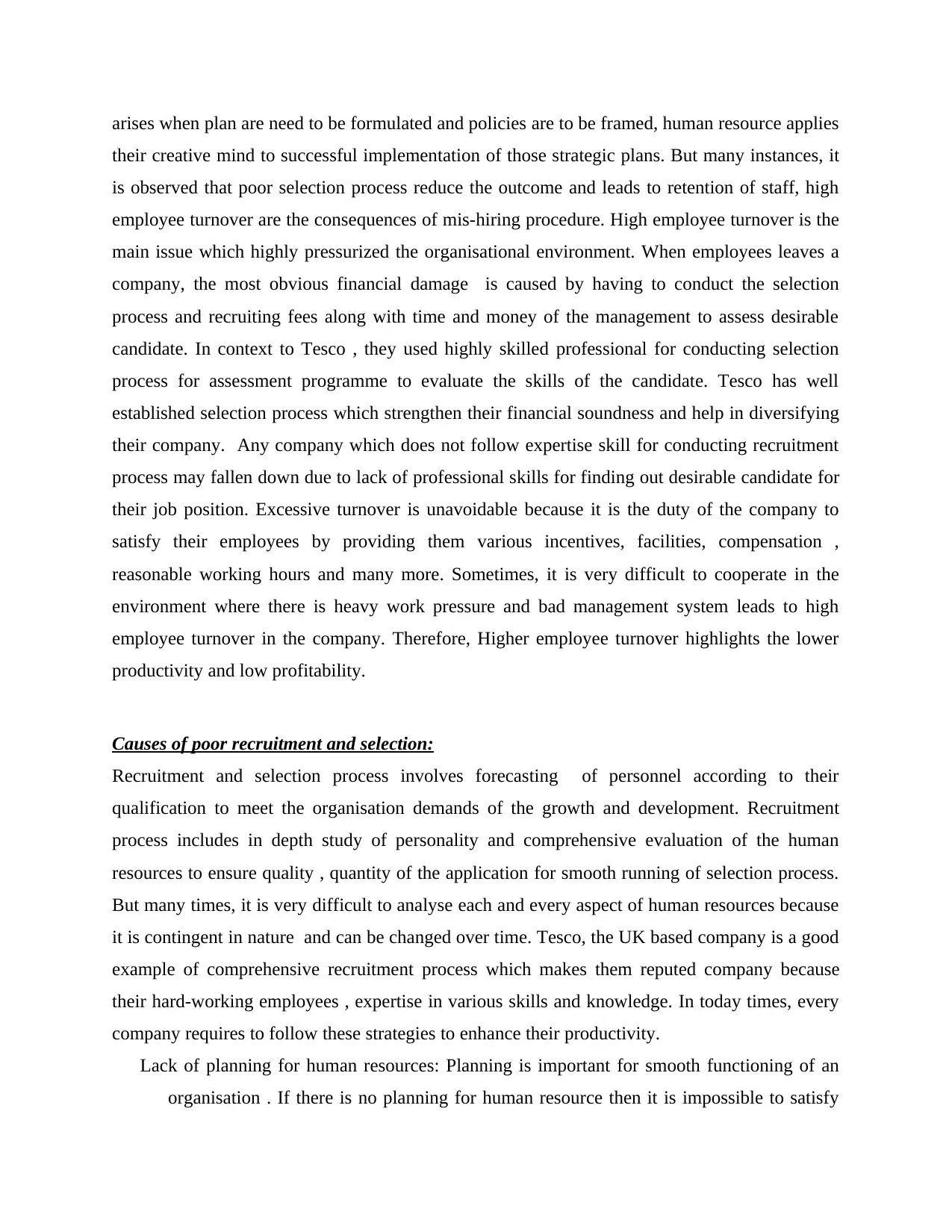
arises when plan are need to be formulated and policies are to be framed, human resource applies
their creative mind to successful implementation of those strategic plans. But many instances, it
is observed that poor selection process reduce the outcome and leads to retention of staff, high
employee turnover are the consequences of mis-hiring procedure. High employee turnover is the
main issue which highly pressurized the organisational environment. When employees leaves a
company, the most obvious financial damage is caused by having to conduct the selection
process and recruiting fees along with time and money of the management to assess desirable
candidate. In context to Tesco , they used highly skilled professional for conducting selection
process for assessment programme to evaluate the skills of the candidate. Tesco has well
established selection process which strengthen their financial soundness and help in diversifying
their company. Any company which does not follow expertise skill for conducting recruitment
process may fallen down due to lack of professional skills for finding out desirable candidate for
their job position. Excessive turnover is unavoidable because it is the duty of the company to
satisfy their employees by providing them various incentives, facilities, compensation ,
reasonable working hours and many more. Sometimes, it is very difficult to cooperate in the
environment where there is heavy work pressure and bad management system leads to high
employee turnover in the company. Therefore, Higher employee turnover highlights the lower
productivity and low profitability.
Causes of poor recruitment and selection:
Recruitment and selection process involves forecasting of personnel according to their
qualification to meet the organisation demands of the growth and development. Recruitment
process includes in depth study of personality and comprehensive evaluation of the human
resources to ensure quality , quantity of the application for smooth running of selection process.
But many times, it is very difficult to analyse each and every aspect of human resources because
it is contingent in nature and can be changed over time. Tesco, the UK based company is a good
example of comprehensive recruitment process which makes them reputed company because
their hard-working employees , expertise in various skills and knowledge. In today times, every
company requires to follow these strategies to enhance their productivity.
Lack of planning for human resources: Planning is important for smooth functioning of an
organisation . If there is no planning for human resource then it is impossible to satisfy
their creative mind to successful implementation of those strategic plans. But many instances, it
is observed that poor selection process reduce the outcome and leads to retention of staff, high
employee turnover are the consequences of mis-hiring procedure. High employee turnover is the
main issue which highly pressurized the organisational environment. When employees leaves a
company, the most obvious financial damage is caused by having to conduct the selection
process and recruiting fees along with time and money of the management to assess desirable
candidate. In context to Tesco , they used highly skilled professional for conducting selection
process for assessment programme to evaluate the skills of the candidate. Tesco has well
established selection process which strengthen their financial soundness and help in diversifying
their company. Any company which does not follow expertise skill for conducting recruitment
process may fallen down due to lack of professional skills for finding out desirable candidate for
their job position. Excessive turnover is unavoidable because it is the duty of the company to
satisfy their employees by providing them various incentives, facilities, compensation ,
reasonable working hours and many more. Sometimes, it is very difficult to cooperate in the
environment where there is heavy work pressure and bad management system leads to high
employee turnover in the company. Therefore, Higher employee turnover highlights the lower
productivity and low profitability.
Causes of poor recruitment and selection:
Recruitment and selection process involves forecasting of personnel according to their
qualification to meet the organisation demands of the growth and development. Recruitment
process includes in depth study of personality and comprehensive evaluation of the human
resources to ensure quality , quantity of the application for smooth running of selection process.
But many times, it is very difficult to analyse each and every aspect of human resources because
it is contingent in nature and can be changed over time. Tesco, the UK based company is a good
example of comprehensive recruitment process which makes them reputed company because
their hard-working employees , expertise in various skills and knowledge. In today times, every
company requires to follow these strategies to enhance their productivity.
Lack of planning for human resources: Planning is important for smooth functioning of an
organisation . If there is no planning for human resource then it is impossible to satisfy
⊘ This is a preview!⊘
Do you want full access?
Subscribe today to unlock all pages.

Trusted by 1+ million students worldwide
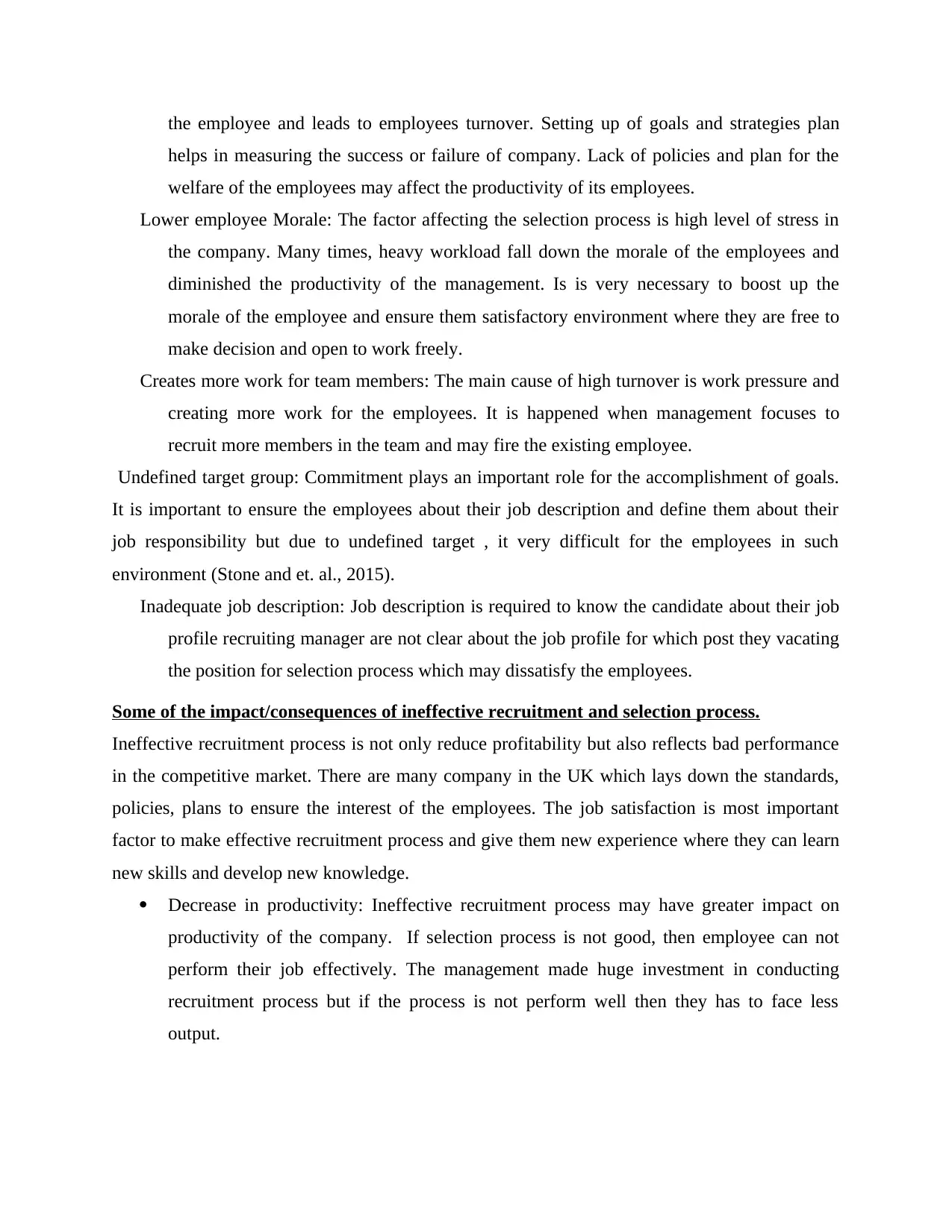
the employee and leads to employees turnover. Setting up of goals and strategies plan
helps in measuring the success or failure of company. Lack of policies and plan for the
welfare of the employees may affect the productivity of its employees.
Lower employee Morale: The factor affecting the selection process is high level of stress in
the company. Many times, heavy workload fall down the morale of the employees and
diminished the productivity of the management. Is is very necessary to boost up the
morale of the employee and ensure them satisfactory environment where they are free to
make decision and open to work freely.
Creates more work for team members: The main cause of high turnover is work pressure and
creating more work for the employees. It is happened when management focuses to
recruit more members in the team and may fire the existing employee.
Undefined target group: Commitment plays an important role for the accomplishment of goals.
It is important to ensure the employees about their job description and define them about their
job responsibility but due to undefined target , it very difficult for the employees in such
environment (Stone and et. al., 2015).
Inadequate job description: Job description is required to know the candidate about their job
profile recruiting manager are not clear about the job profile for which post they vacating
the position for selection process which may dissatisfy the employees.
Some of the impact/consequences of ineffective recruitment and selection process.
Ineffective recruitment process is not only reduce profitability but also reflects bad performance
in the competitive market. There are many company in the UK which lays down the standards,
policies, plans to ensure the interest of the employees. The job satisfaction is most important
factor to make effective recruitment process and give them new experience where they can learn
new skills and develop new knowledge.
Decrease in productivity: Ineffective recruitment process may have greater impact on
productivity of the company. If selection process is not good, then employee can not
perform their job effectively. The management made huge investment in conducting
recruitment process but if the process is not perform well then they has to face less
output.
helps in measuring the success or failure of company. Lack of policies and plan for the
welfare of the employees may affect the productivity of its employees.
Lower employee Morale: The factor affecting the selection process is high level of stress in
the company. Many times, heavy workload fall down the morale of the employees and
diminished the productivity of the management. Is is very necessary to boost up the
morale of the employee and ensure them satisfactory environment where they are free to
make decision and open to work freely.
Creates more work for team members: The main cause of high turnover is work pressure and
creating more work for the employees. It is happened when management focuses to
recruit more members in the team and may fire the existing employee.
Undefined target group: Commitment plays an important role for the accomplishment of goals.
It is important to ensure the employees about their job description and define them about their
job responsibility but due to undefined target , it very difficult for the employees in such
environment (Stone and et. al., 2015).
Inadequate job description: Job description is required to know the candidate about their job
profile recruiting manager are not clear about the job profile for which post they vacating
the position for selection process which may dissatisfy the employees.
Some of the impact/consequences of ineffective recruitment and selection process.
Ineffective recruitment process is not only reduce profitability but also reflects bad performance
in the competitive market. There are many company in the UK which lays down the standards,
policies, plans to ensure the interest of the employees. The job satisfaction is most important
factor to make effective recruitment process and give them new experience where they can learn
new skills and develop new knowledge.
Decrease in productivity: Ineffective recruitment process may have greater impact on
productivity of the company. If selection process is not good, then employee can not
perform their job effectively. The management made huge investment in conducting
recruitment process but if the process is not perform well then they has to face less
output.
Paraphrase This Document
Need a fresh take? Get an instant paraphrase of this document with our AI Paraphraser
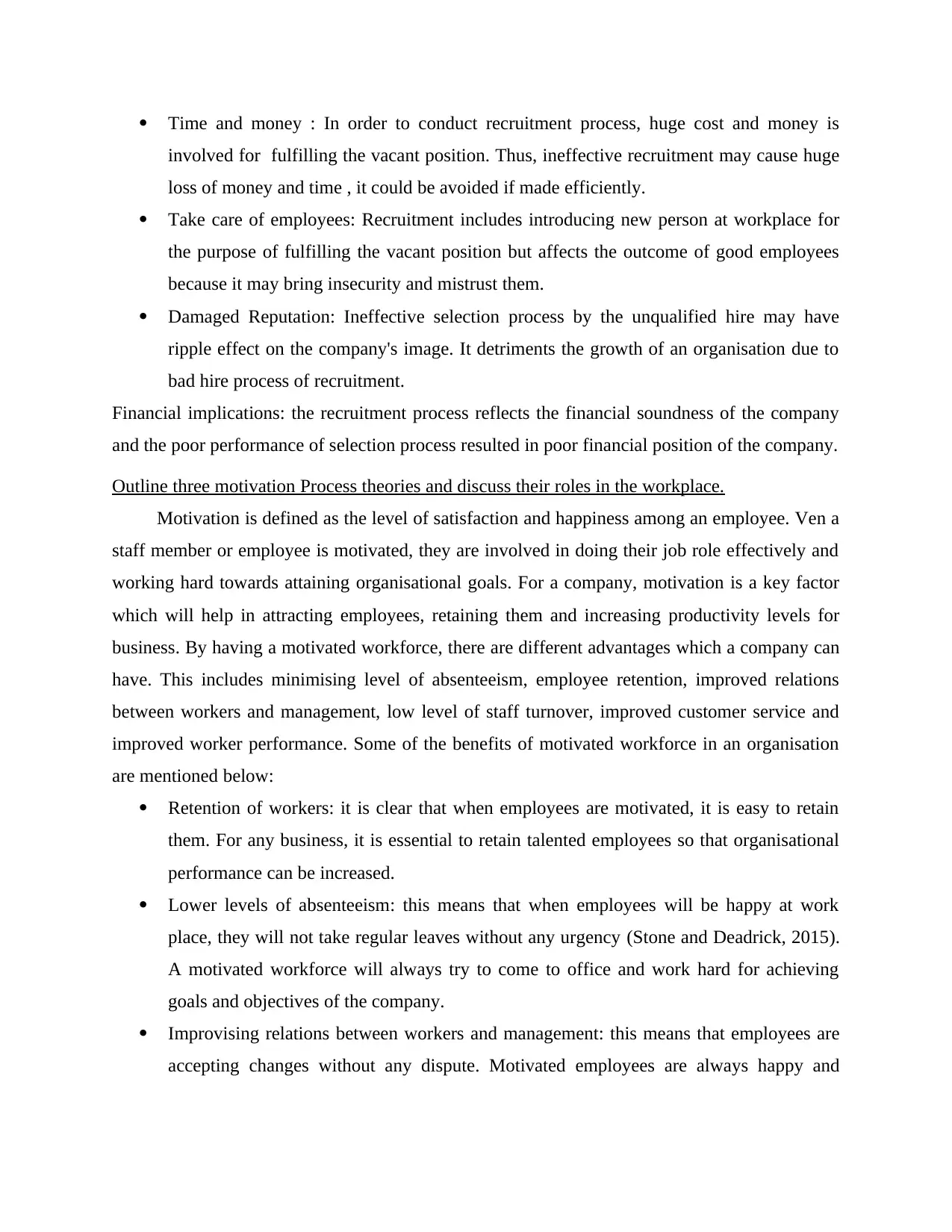
Time and money : In order to conduct recruitment process, huge cost and money is
involved for fulfilling the vacant position. Thus, ineffective recruitment may cause huge
loss of money and time , it could be avoided if made efficiently.
Take care of employees: Recruitment includes introducing new person at workplace for
the purpose of fulfilling the vacant position but affects the outcome of good employees
because it may bring insecurity and mistrust them.
Damaged Reputation: Ineffective selection process by the unqualified hire may have
ripple effect on the company's image. It detriments the growth of an organisation due to
bad hire process of recruitment.
Financial implications: the recruitment process reflects the financial soundness of the company
and the poor performance of selection process resulted in poor financial position of the company.
Outline three motivation Process theories and discuss their roles in the workplace.
Motivation is defined as the level of satisfaction and happiness among an employee. Ven a
staff member or employee is motivated, they are involved in doing their job role effectively and
working hard towards attaining organisational goals. For a company, motivation is a key factor
which will help in attracting employees, retaining them and increasing productivity levels for
business. By having a motivated workforce, there are different advantages which a company can
have. This includes minimising level of absenteeism, employee retention, improved relations
between workers and management, low level of staff turnover, improved customer service and
improved worker performance. Some of the benefits of motivated workforce in an organisation
are mentioned below:
Retention of workers: it is clear that when employees are motivated, it is easy to retain
them. For any business, it is essential to retain talented employees so that organisational
performance can be increased.
Lower levels of absenteeism: this means that when employees will be happy at work
place, they will not take regular leaves without any urgency (Stone and Deadrick, 2015).
A motivated workforce will always try to come to office and work hard for achieving
goals and objectives of the company.
Improvising relations between workers and management: this means that employees are
accepting changes without any dispute. Motivated employees are always happy and
involved for fulfilling the vacant position. Thus, ineffective recruitment may cause huge
loss of money and time , it could be avoided if made efficiently.
Take care of employees: Recruitment includes introducing new person at workplace for
the purpose of fulfilling the vacant position but affects the outcome of good employees
because it may bring insecurity and mistrust them.
Damaged Reputation: Ineffective selection process by the unqualified hire may have
ripple effect on the company's image. It detriments the growth of an organisation due to
bad hire process of recruitment.
Financial implications: the recruitment process reflects the financial soundness of the company
and the poor performance of selection process resulted in poor financial position of the company.
Outline three motivation Process theories and discuss their roles in the workplace.
Motivation is defined as the level of satisfaction and happiness among an employee. Ven a
staff member or employee is motivated, they are involved in doing their job role effectively and
working hard towards attaining organisational goals. For a company, motivation is a key factor
which will help in attracting employees, retaining them and increasing productivity levels for
business. By having a motivated workforce, there are different advantages which a company can
have. This includes minimising level of absenteeism, employee retention, improved relations
between workers and management, low level of staff turnover, improved customer service and
improved worker performance. Some of the benefits of motivated workforce in an organisation
are mentioned below:
Retention of workers: it is clear that when employees are motivated, it is easy to retain
them. For any business, it is essential to retain talented employees so that organisational
performance can be increased.
Lower levels of absenteeism: this means that when employees will be happy at work
place, they will not take regular leaves without any urgency (Stone and Deadrick, 2015).
A motivated workforce will always try to come to office and work hard for achieving
goals and objectives of the company.
Improvising relations between workers and management: this means that employees are
accepting changes without any dispute. Motivated employees are always happy and
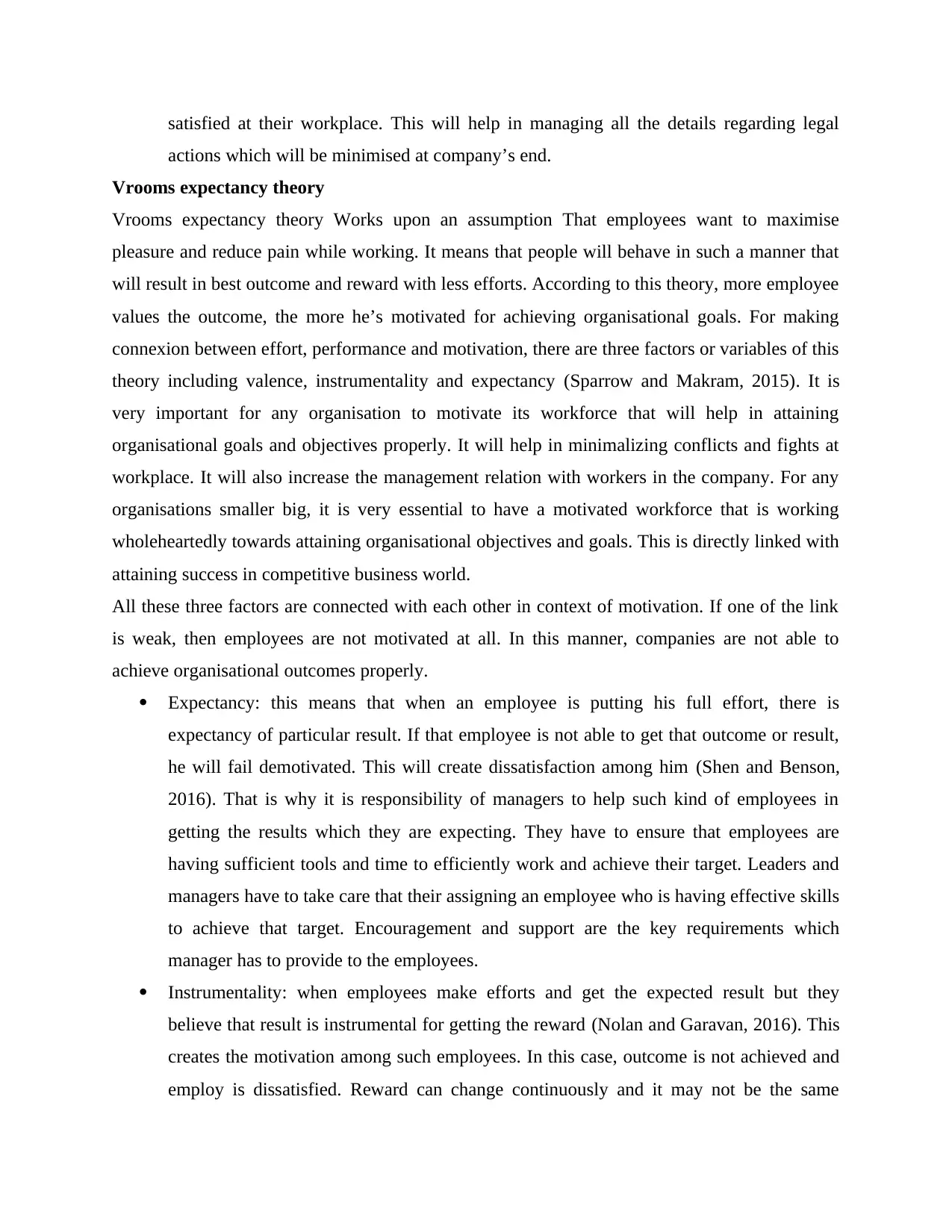
satisfied at their workplace. This will help in managing all the details regarding legal
actions which will be minimised at company’s end.
Vrooms expectancy theory
Vrooms expectancy theory Works upon an assumption That employees want to maximise
pleasure and reduce pain while working. It means that people will behave in such a manner that
will result in best outcome and reward with less efforts. According to this theory, more employee
values the outcome, the more he’s motivated for achieving organisational goals. For making
connexion between effort, performance and motivation, there are three factors or variables of this
theory including valence, instrumentality and expectancy (Sparrow and Makram, 2015). It is
very important for any organisation to motivate its workforce that will help in attaining
organisational goals and objectives properly. It will help in minimalizing conflicts and fights at
workplace. It will also increase the management relation with workers in the company. For any
organisations smaller big, it is very essential to have a motivated workforce that is working
wholeheartedly towards attaining organisational objectives and goals. This is directly linked with
attaining success in competitive business world.
All these three factors are connected with each other in context of motivation. If one of the link
is weak, then employees are not motivated at all. In this manner, companies are not able to
achieve organisational outcomes properly.
Expectancy: this means that when an employee is putting his full effort, there is
expectancy of particular result. If that employee is not able to get that outcome or result,
he will fail demotivated. This will create dissatisfaction among him (Shen and Benson,
2016). That is why it is responsibility of managers to help such kind of employees in
getting the results which they are expecting. They have to ensure that employees are
having sufficient tools and time to efficiently work and achieve their target. Leaders and
managers have to take care that their assigning an employee who is having effective skills
to achieve that target. Encouragement and support are the key requirements which
manager has to provide to the employees.
Instrumentality: when employees make efforts and get the expected result but they
believe that result is instrumental for getting the reward (Nolan and Garavan, 2016). This
creates the motivation among such employees. In this case, outcome is not achieved and
employ is dissatisfied. Reward can change continuously and it may not be the same
actions which will be minimised at company’s end.
Vrooms expectancy theory
Vrooms expectancy theory Works upon an assumption That employees want to maximise
pleasure and reduce pain while working. It means that people will behave in such a manner that
will result in best outcome and reward with less efforts. According to this theory, more employee
values the outcome, the more he’s motivated for achieving organisational goals. For making
connexion between effort, performance and motivation, there are three factors or variables of this
theory including valence, instrumentality and expectancy (Sparrow and Makram, 2015). It is
very important for any organisation to motivate its workforce that will help in attaining
organisational goals and objectives properly. It will help in minimalizing conflicts and fights at
workplace. It will also increase the management relation with workers in the company. For any
organisations smaller big, it is very essential to have a motivated workforce that is working
wholeheartedly towards attaining organisational objectives and goals. This is directly linked with
attaining success in competitive business world.
All these three factors are connected with each other in context of motivation. If one of the link
is weak, then employees are not motivated at all. In this manner, companies are not able to
achieve organisational outcomes properly.
Expectancy: this means that when an employee is putting his full effort, there is
expectancy of particular result. If that employee is not able to get that outcome or result,
he will fail demotivated. This will create dissatisfaction among him (Shen and Benson,
2016). That is why it is responsibility of managers to help such kind of employees in
getting the results which they are expecting. They have to ensure that employees are
having sufficient tools and time to efficiently work and achieve their target. Leaders and
managers have to take care that their assigning an employee who is having effective skills
to achieve that target. Encouragement and support are the key requirements which
manager has to provide to the employees.
Instrumentality: when employees make efforts and get the expected result but they
believe that result is instrumental for getting the reward (Nolan and Garavan, 2016). This
creates the motivation among such employees. In this case, outcome is not achieved and
employ is dissatisfied. Reward can change continuously and it may not be the same
⊘ This is a preview!⊘
Do you want full access?
Subscribe today to unlock all pages.

Trusted by 1+ million students worldwide
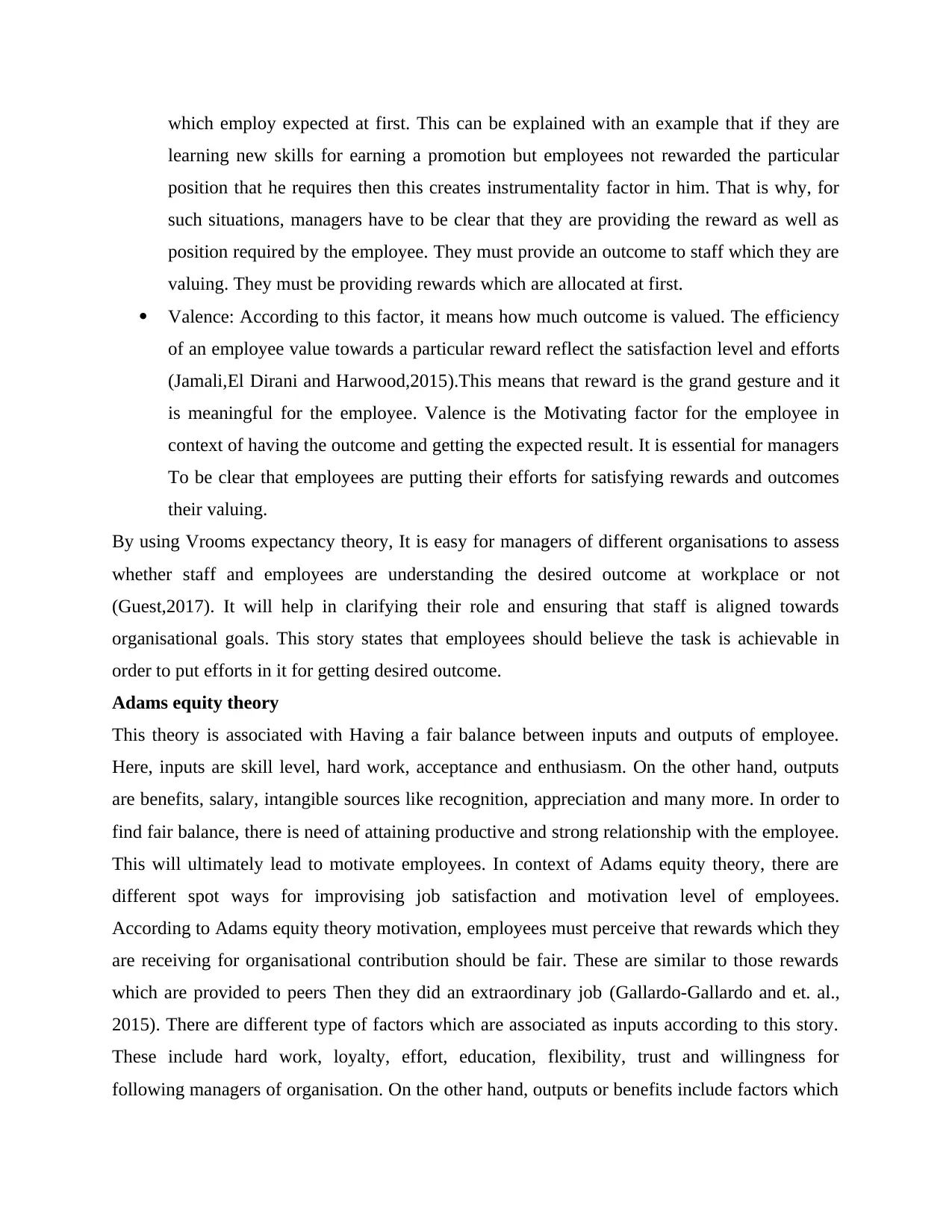
which employ expected at first. This can be explained with an example that if they are
learning new skills for earning a promotion but employees not rewarded the particular
position that he requires then this creates instrumentality factor in him. That is why, for
such situations, managers have to be clear that they are providing the reward as well as
position required by the employee. They must provide an outcome to staff which they are
valuing. They must be providing rewards which are allocated at first.
Valence: According to this factor, it means how much outcome is valued. The efficiency
of an employee value towards a particular reward reflect the satisfaction level and efforts
(Jamali,El Dirani and Harwood,2015).This means that reward is the grand gesture and it
is meaningful for the employee. Valence is the Motivating factor for the employee in
context of having the outcome and getting the expected result. It is essential for managers
To be clear that employees are putting their efforts for satisfying rewards and outcomes
their valuing.
By using Vrooms expectancy theory, It is easy for managers of different organisations to assess
whether staff and employees are understanding the desired outcome at workplace or not
(Guest,2017). It will help in clarifying their role and ensuring that staff is aligned towards
organisational goals. This story states that employees should believe the task is achievable in
order to put efforts in it for getting desired outcome.
Adams equity theory
This theory is associated with Having a fair balance between inputs and outputs of employee.
Here, inputs are skill level, hard work, acceptance and enthusiasm. On the other hand, outputs
are benefits, salary, intangible sources like recognition, appreciation and many more. In order to
find fair balance, there is need of attaining productive and strong relationship with the employee.
This will ultimately lead to motivate employees. In context of Adams equity theory, there are
different spot ways for improvising job satisfaction and motivation level of employees.
According to Adams equity theory motivation, employees must perceive that rewards which they
are receiving for organisational contribution should be fair. These are similar to those rewards
which are provided to peers Then they did an extraordinary job (Gallardo-Gallardo and et. al.,
2015). There are different type of factors which are associated as inputs according to this story.
These include hard work, loyalty, effort, education, flexibility, trust and willingness for
following managers of organisation. On the other hand, outputs or benefits include factors which
learning new skills for earning a promotion but employees not rewarded the particular
position that he requires then this creates instrumentality factor in him. That is why, for
such situations, managers have to be clear that they are providing the reward as well as
position required by the employee. They must provide an outcome to staff which they are
valuing. They must be providing rewards which are allocated at first.
Valence: According to this factor, it means how much outcome is valued. The efficiency
of an employee value towards a particular reward reflect the satisfaction level and efforts
(Jamali,El Dirani and Harwood,2015).This means that reward is the grand gesture and it
is meaningful for the employee. Valence is the Motivating factor for the employee in
context of having the outcome and getting the expected result. It is essential for managers
To be clear that employees are putting their efforts for satisfying rewards and outcomes
their valuing.
By using Vrooms expectancy theory, It is easy for managers of different organisations to assess
whether staff and employees are understanding the desired outcome at workplace or not
(Guest,2017). It will help in clarifying their role and ensuring that staff is aligned towards
organisational goals. This story states that employees should believe the task is achievable in
order to put efforts in it for getting desired outcome.
Adams equity theory
This theory is associated with Having a fair balance between inputs and outputs of employee.
Here, inputs are skill level, hard work, acceptance and enthusiasm. On the other hand, outputs
are benefits, salary, intangible sources like recognition, appreciation and many more. In order to
find fair balance, there is need of attaining productive and strong relationship with the employee.
This will ultimately lead to motivate employees. In context of Adams equity theory, there are
different spot ways for improvising job satisfaction and motivation level of employees.
According to Adams equity theory motivation, employees must perceive that rewards which they
are receiving for organisational contribution should be fair. These are similar to those rewards
which are provided to peers Then they did an extraordinary job (Gallardo-Gallardo and et. al.,
2015). There are different type of factors which are associated as inputs according to this story.
These include hard work, loyalty, effort, education, flexibility, trust and willingness for
following managers of organisation. On the other hand, outputs or benefits include factors which
Paraphrase This Document
Need a fresh take? Get an instant paraphrase of this document with our AI Paraphraser
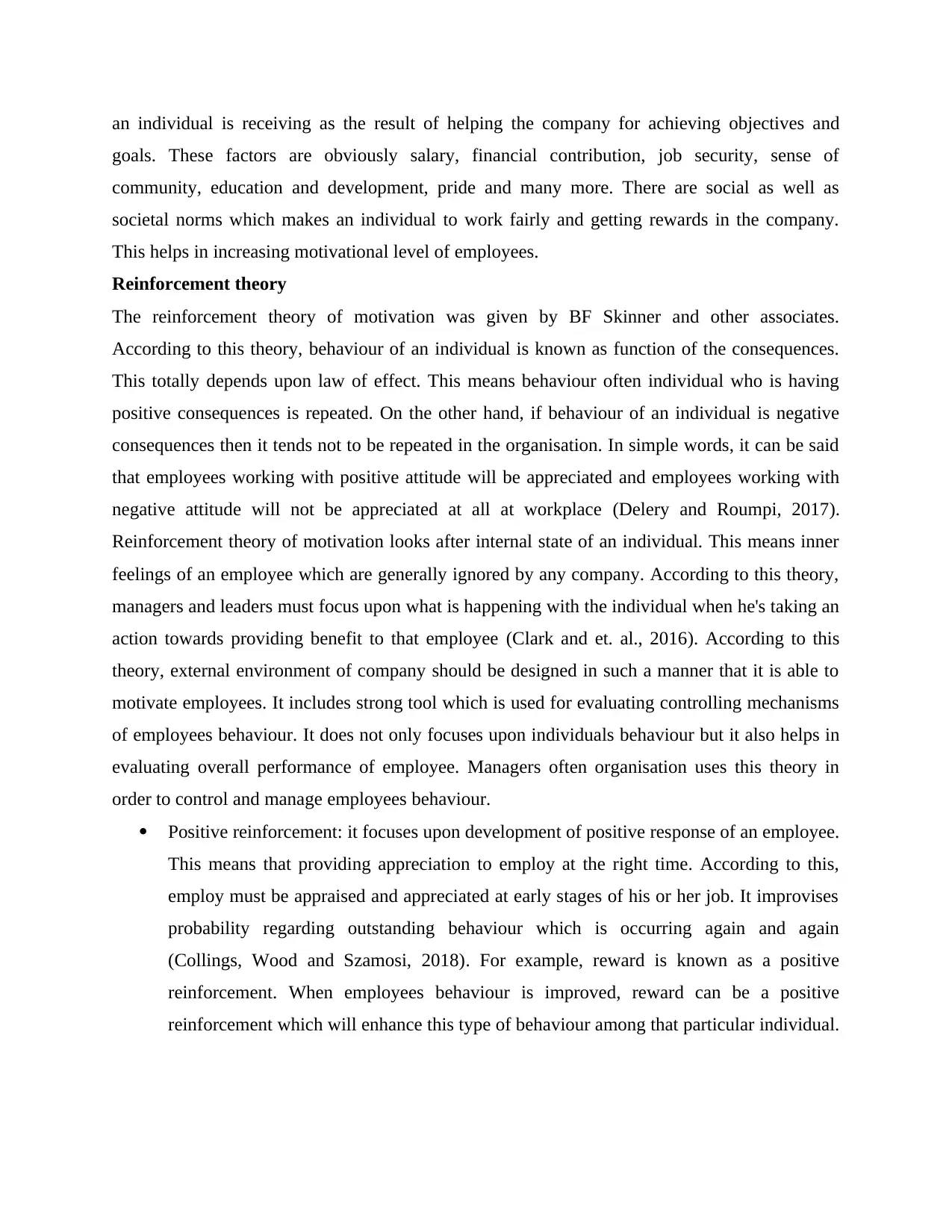
an individual is receiving as the result of helping the company for achieving objectives and
goals. These factors are obviously salary, financial contribution, job security, sense of
community, education and development, pride and many more. There are social as well as
societal norms which makes an individual to work fairly and getting rewards in the company.
This helps in increasing motivational level of employees.
Reinforcement theory
The reinforcement theory of motivation was given by BF Skinner and other associates.
According to this theory, behaviour of an individual is known as function of the consequences.
This totally depends upon law of effect. This means behaviour often individual who is having
positive consequences is repeated. On the other hand, if behaviour of an individual is negative
consequences then it tends not to be repeated in the organisation. In simple words, it can be said
that employees working with positive attitude will be appreciated and employees working with
negative attitude will not be appreciated at all at workplace (Delery and Roumpi, 2017).
Reinforcement theory of motivation looks after internal state of an individual. This means inner
feelings of an employee which are generally ignored by any company. According to this theory,
managers and leaders must focus upon what is happening with the individual when he's taking an
action towards providing benefit to that employee (Clark and et. al., 2016). According to this
theory, external environment of company should be designed in such a manner that it is able to
motivate employees. It includes strong tool which is used for evaluating controlling mechanisms
of employees behaviour. It does not only focuses upon individuals behaviour but it also helps in
evaluating overall performance of employee. Managers often organisation uses this theory in
order to control and manage employees behaviour.
Positive reinforcement: it focuses upon development of positive response of an employee.
This means that providing appreciation to employ at the right time. According to this,
employ must be appraised and appreciated at early stages of his or her job. It improvises
probability regarding outstanding behaviour which is occurring again and again
(Collings, Wood and Szamosi, 2018). For example, reward is known as a positive
reinforcement. When employees behaviour is improved, reward can be a positive
reinforcement which will enhance this type of behaviour among that particular individual.
goals. These factors are obviously salary, financial contribution, job security, sense of
community, education and development, pride and many more. There are social as well as
societal norms which makes an individual to work fairly and getting rewards in the company.
This helps in increasing motivational level of employees.
Reinforcement theory
The reinforcement theory of motivation was given by BF Skinner and other associates.
According to this theory, behaviour of an individual is known as function of the consequences.
This totally depends upon law of effect. This means behaviour often individual who is having
positive consequences is repeated. On the other hand, if behaviour of an individual is negative
consequences then it tends not to be repeated in the organisation. In simple words, it can be said
that employees working with positive attitude will be appreciated and employees working with
negative attitude will not be appreciated at all at workplace (Delery and Roumpi, 2017).
Reinforcement theory of motivation looks after internal state of an individual. This means inner
feelings of an employee which are generally ignored by any company. According to this theory,
managers and leaders must focus upon what is happening with the individual when he's taking an
action towards providing benefit to that employee (Clark and et. al., 2016). According to this
theory, external environment of company should be designed in such a manner that it is able to
motivate employees. It includes strong tool which is used for evaluating controlling mechanisms
of employees behaviour. It does not only focuses upon individuals behaviour but it also helps in
evaluating overall performance of employee. Managers often organisation uses this theory in
order to control and manage employees behaviour.
Positive reinforcement: it focuses upon development of positive response of an employee.
This means that providing appreciation to employ at the right time. According to this,
employ must be appraised and appreciated at early stages of his or her job. It improvises
probability regarding outstanding behaviour which is occurring again and again
(Collings, Wood and Szamosi, 2018). For example, reward is known as a positive
reinforcement. When employees behaviour is improved, reward can be a positive
reinforcement which will enhance this type of behaviour among that particular individual.
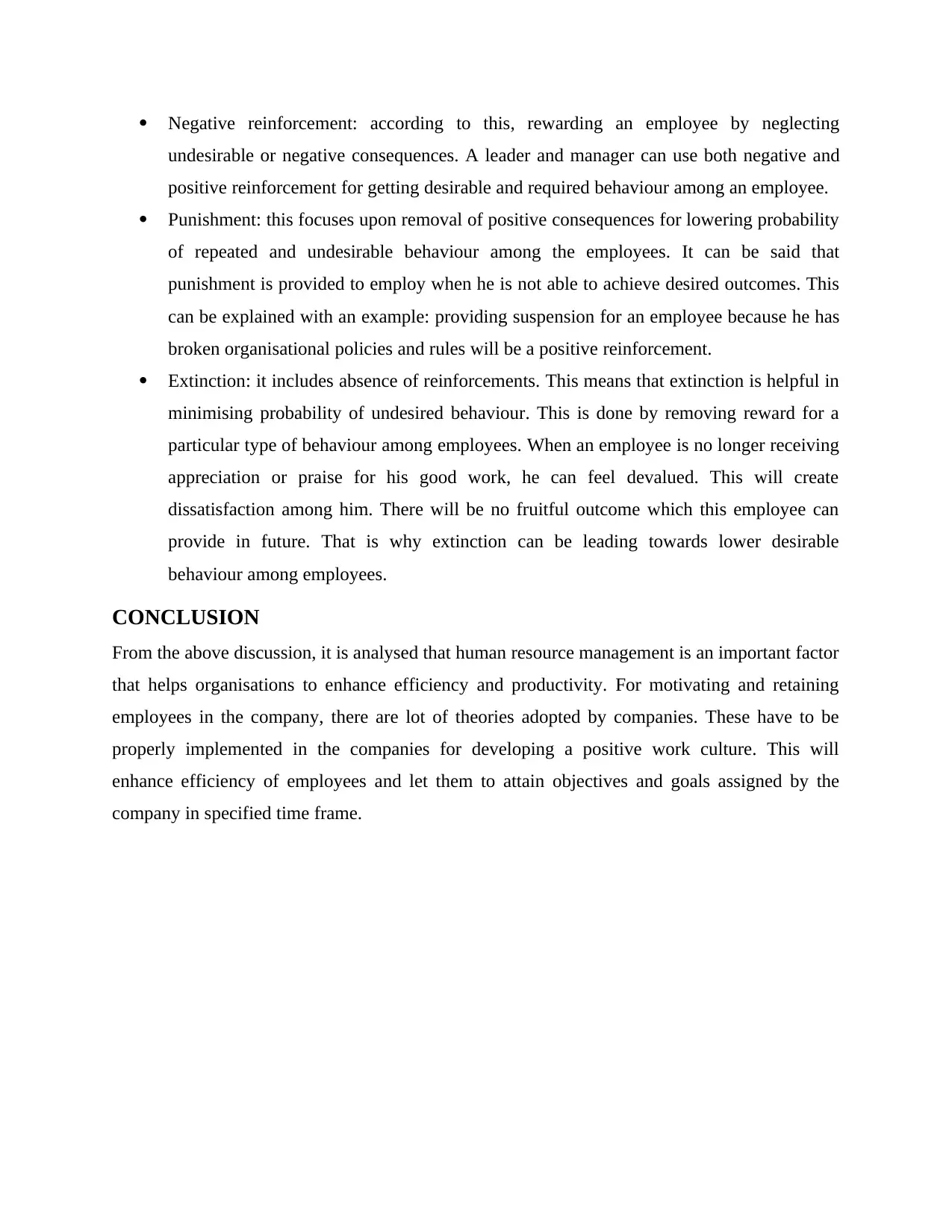
Negative reinforcement: according to this, rewarding an employee by neglecting
undesirable or negative consequences. A leader and manager can use both negative and
positive reinforcement for getting desirable and required behaviour among an employee.
Punishment: this focuses upon removal of positive consequences for lowering probability
of repeated and undesirable behaviour among the employees. It can be said that
punishment is provided to employ when he is not able to achieve desired outcomes. This
can be explained with an example: providing suspension for an employee because he has
broken organisational policies and rules will be a positive reinforcement.
Extinction: it includes absence of reinforcements. This means that extinction is helpful in
minimising probability of undesired behaviour. This is done by removing reward for a
particular type of behaviour among employees. When an employee is no longer receiving
appreciation or praise for his good work, he can feel devalued. This will create
dissatisfaction among him. There will be no fruitful outcome which this employee can
provide in future. That is why extinction can be leading towards lower desirable
behaviour among employees.
CONCLUSION
From the above discussion, it is analysed that human resource management is an important factor
that helps organisations to enhance efficiency and productivity. For motivating and retaining
employees in the company, there are lot of theories adopted by companies. These have to be
properly implemented in the companies for developing a positive work culture. This will
enhance efficiency of employees and let them to attain objectives and goals assigned by the
company in specified time frame.
undesirable or negative consequences. A leader and manager can use both negative and
positive reinforcement for getting desirable and required behaviour among an employee.
Punishment: this focuses upon removal of positive consequences for lowering probability
of repeated and undesirable behaviour among the employees. It can be said that
punishment is provided to employ when he is not able to achieve desired outcomes. This
can be explained with an example: providing suspension for an employee because he has
broken organisational policies and rules will be a positive reinforcement.
Extinction: it includes absence of reinforcements. This means that extinction is helpful in
minimising probability of undesired behaviour. This is done by removing reward for a
particular type of behaviour among employees. When an employee is no longer receiving
appreciation or praise for his good work, he can feel devalued. This will create
dissatisfaction among him. There will be no fruitful outcome which this employee can
provide in future. That is why extinction can be leading towards lower desirable
behaviour among employees.
CONCLUSION
From the above discussion, it is analysed that human resource management is an important factor
that helps organisations to enhance efficiency and productivity. For motivating and retaining
employees in the company, there are lot of theories adopted by companies. These have to be
properly implemented in the companies for developing a positive work culture. This will
enhance efficiency of employees and let them to attain objectives and goals assigned by the
company in specified time frame.
⊘ This is a preview!⊘
Do you want full access?
Subscribe today to unlock all pages.

Trusted by 1+ million students worldwide
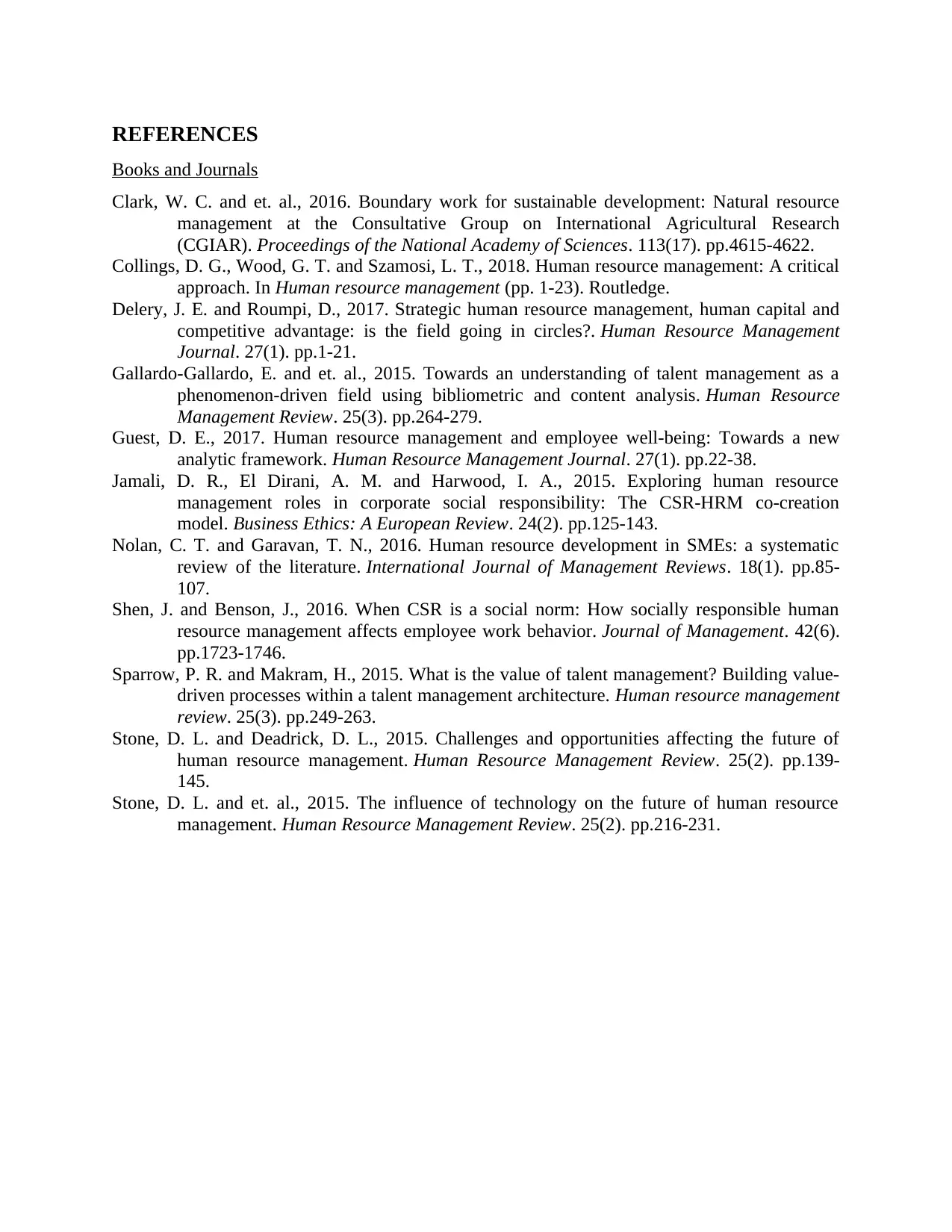
REFERENCES
Books and Journals
Clark, W. C. and et. al., 2016. Boundary work for sustainable development: Natural resource
management at the Consultative Group on International Agricultural Research
(CGIAR). Proceedings of the National Academy of Sciences. 113(17). pp.4615-4622.
Collings, D. G., Wood, G. T. and Szamosi, L. T., 2018. Human resource management: A critical
approach. In Human resource management (pp. 1-23). Routledge.
Delery, J. E. and Roumpi, D., 2017. Strategic human resource management, human capital and
competitive advantage: is the field going in circles?. Human Resource Management
Journal. 27(1). pp.1-21.
Gallardo-Gallardo, E. and et. al., 2015. Towards an understanding of talent management as a
phenomenon-driven field using bibliometric and content analysis. Human Resource
Management Review. 25(3). pp.264-279.
Guest, D. E., 2017. Human resource management and employee well‐being: Towards a new
analytic framework. Human Resource Management Journal. 27(1). pp.22-38.
Jamali, D. R., El Dirani, A. M. and Harwood, I. A., 2015. Exploring human resource
management roles in corporate social responsibility: The CSR‐HRM co‐creation
model. Business Ethics: A European Review. 24(2). pp.125-143.
Nolan, C. T. and Garavan, T. N., 2016. Human resource development in SMEs: a systematic
review of the literature. International Journal of Management Reviews. 18(1). pp.85-
107.
Shen, J. and Benson, J., 2016. When CSR is a social norm: How socially responsible human
resource management affects employee work behavior. Journal of Management. 42(6).
pp.1723-1746.
Sparrow, P. R. and Makram, H., 2015. What is the value of talent management? Building value-
driven processes within a talent management architecture. Human resource management
review. 25(3). pp.249-263.
Stone, D. L. and Deadrick, D. L., 2015. Challenges and opportunities affecting the future of
human resource management. Human Resource Management Review. 25(2). pp.139-
145.
Stone, D. L. and et. al., 2015. The influence of technology on the future of human resource
management. Human Resource Management Review. 25(2). pp.216-231.
Books and Journals
Clark, W. C. and et. al., 2016. Boundary work for sustainable development: Natural resource
management at the Consultative Group on International Agricultural Research
(CGIAR). Proceedings of the National Academy of Sciences. 113(17). pp.4615-4622.
Collings, D. G., Wood, G. T. and Szamosi, L. T., 2018. Human resource management: A critical
approach. In Human resource management (pp. 1-23). Routledge.
Delery, J. E. and Roumpi, D., 2017. Strategic human resource management, human capital and
competitive advantage: is the field going in circles?. Human Resource Management
Journal. 27(1). pp.1-21.
Gallardo-Gallardo, E. and et. al., 2015. Towards an understanding of talent management as a
phenomenon-driven field using bibliometric and content analysis. Human Resource
Management Review. 25(3). pp.264-279.
Guest, D. E., 2017. Human resource management and employee well‐being: Towards a new
analytic framework. Human Resource Management Journal. 27(1). pp.22-38.
Jamali, D. R., El Dirani, A. M. and Harwood, I. A., 2015. Exploring human resource
management roles in corporate social responsibility: The CSR‐HRM co‐creation
model. Business Ethics: A European Review. 24(2). pp.125-143.
Nolan, C. T. and Garavan, T. N., 2016. Human resource development in SMEs: a systematic
review of the literature. International Journal of Management Reviews. 18(1). pp.85-
107.
Shen, J. and Benson, J., 2016. When CSR is a social norm: How socially responsible human
resource management affects employee work behavior. Journal of Management. 42(6).
pp.1723-1746.
Sparrow, P. R. and Makram, H., 2015. What is the value of talent management? Building value-
driven processes within a talent management architecture. Human resource management
review. 25(3). pp.249-263.
Stone, D. L. and Deadrick, D. L., 2015. Challenges and opportunities affecting the future of
human resource management. Human Resource Management Review. 25(2). pp.139-
145.
Stone, D. L. and et. al., 2015. The influence of technology on the future of human resource
management. Human Resource Management Review. 25(2). pp.216-231.
1 out of 10
Related Documents
Your All-in-One AI-Powered Toolkit for Academic Success.
+13062052269
info@desklib.com
Available 24*7 on WhatsApp / Email
![[object Object]](/_next/static/media/star-bottom.7253800d.svg)
Unlock your academic potential
Copyright © 2020–2025 A2Z Services. All Rights Reserved. Developed and managed by ZUCOL.





